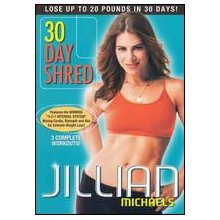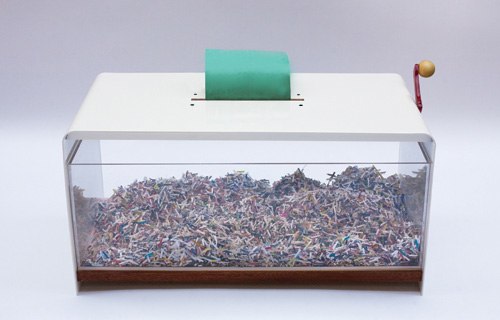Shredding the Documents: Find Your Shredding Solution
Outside of the organizing world, shredding has a few different meanings. To the Beautiful People, it’s Jillian Michaels’ (agonizing) 30 Day Shred, creating abs to die for (a process which might kill some of us). Snowboarding and skateboarding stars revel in their ability to shred when displaying extreme sports prowess. To the Guitar Hero set, shredding means kicking butt (musically) with super-speedy electric guitar, as displayed during Stephen Colbert’s Shred-Off
Snowboarding and skateboarding stars revel in their ability to shred when displaying extreme sports prowess. To the Guitar Hero set, shredding means kicking butt (musically) with super-speedy electric guitar, as displayed during Stephen Colbert’s Shred-Off  , preceded by the famed Countdown to Guitarmageddon. (Haven’t you always wondered how this blog would sound if narrated by Henry Kissinger?)
, preceded by the famed Countdown to Guitarmageddon. (Haven’t you always wondered how this blog would sound if narrated by Henry Kissinger?)
But to professional organizers, shredding has the magical properties of alchemy. Instead of turning base metals into gold, shredding turns the fodder for identity theft into Kryptonite, keeping our privacy safe and our data secure.
Last week, we talked about why I feel stampers are inferior to shredders in almost every practical regard, and we’ve discussed time and again how protecting your identity by shredding sensitive documents is key to organizing your financial life.
Yet many people still aren’t shredding. There are two main reasons why those who know they should shred, don’t shred:
- They don’t know what to shred.
- They don’t have a way to shred.
To conquer the first, consult a strong records retention schedule and shred whatever documents no longer need to be retained and which contain personally identifying information. Today’s post addresses the second conundrum.
DO IT YOURSELF
In most cases, consistent use of a medium-sized shredder for your home office or small business should suffice to keep the backlog at bay and keep your papers from piling up. If you don’t yet have a shredder, or are in the market for a new one, some of the basic things to consider are:
Shred Size — You want a cross-cut or micro-cut shredder. The older style strip-cut shredders offer less protection against prying eyes. Cross-cut shredders reduce your paper to hanging chads. Micro-cut shredders pulverize papers even more finely, but may be overkill (in terms of both function and cost) for personal use.
Capacity — There are three key criteria:
1) How many sheets of paper can you feed at one time? While shredders are generally rated by number of sheets shredded contemporaneously, Paper Doll believes many manufacturers are a bit too optimistic in self-reporting. Aim for the highest capacity shredder in your budget range.
2) How much paper can you load in any session without the motor pooping out on you? This won’t generally be listed on the box, so take some time to read user reviews at Amazon and elsewhere online.
3) What else can you shred besides paper? While not everyone will have a need to destroy CDs/DVDs, the shredder you select should, at the very least, be able to handle stapled paper and credit cards.
Ease of Use — The main concerns are an adequate-width feeder and an easy-to-empty receptacle or bin. The nicest shredders have a removable bin that slides out like a drawer or tips out like a laundry chute, but these tend to be more expensive than the budget versions, where the shredding mechanism lifts off to reveal a metal or rubber receptacle. Avoid the low-rent shredders that only provide a mechanism to set atop a trash can — these are usually ill-fitting, poorly balanced and lead to a flurry of shreds on your carpet.
Aesthetics — While the design of a shredder shouldn’t be your main concern, an overly noisy or ugly shredder may be a deal breaker. Whenever possible, test a friend’s shredder or ask a sales associate help you test a floor model. The noise a shredder makes isn’t exactly pleasant, but some have more vibration or grinding than others.
Features — Any decent shredder should have an auto-start function, such that as long as your shredder is turned on, you should be able to insert documents to shred. A “forward” function keeps the motor running whether you are shredding or not. The “reverse” function is important for helping you clear paper jams quickly, especially when you feel immediate friction and realize you’re trying to shred too much paper at once.
Size Matters
Clients purchase desktop mini-shredders in hopes that the small size and convenience of easier access will make them more inclined to routinely shred junk mail. However, I find most desktop shredders lack the gravitas needed to handle daily work.
One inconvenient aspect is that the feeders tend to be too small for ease of usability. Typical mail is 8 1/2″ wide, but even smaller paper generally has to be folded in order to fit into desktop feeders. Perhaps Paper Doll is spoiled, but the ability to shred a short stack of 5 or 8 pieces of paper without having to fold or spindle in order to mutilate is essential.
Mini-shredders are not designed for power-shredding, but even applying relaxed standards, they still tend to overheat quickly, either from lumpy paper gumming up the works or over-exhaustion. One major desktop shredder notes, as a feature, that the shredder “runs for 8 minutes on before needing 80 min off for down time”. Eight minutes of service, followed by an hour and twenty minutes of rest? Nice work if you can get it!
One client aptly described the desktop shredder that she returned it to the store: “It’s cute, but compared to a regular shredder, it’s kinda like an Easy-Bake Oven vs. a regular stove.”
Size REALLY Matters
For anyone with some extra cash lying around and a quirky decorating sense, Pigeontail Design’s Papervore Coffee Table offers an intriguing, outsized shredding solution.

Measuring 31 inches wide by 16 inches deep by 15 1/2 inches high, the hand-cranked Papervore is made of bent powdercoated aluminum with a mahogany and oak shelf. The fully-removable shredding receptacle is acrylic. (Watch the Papervore video.)
The Papervore has a big personality, and an even bigger footprint. It might be for you if you’d be delighted to have an ever-changing kaleidoscope of colors (depending on what you shred) as part of your dcor.
Of course, the main appeal of a shredder is that it does all the work for you, so if you’re the type of person who eschews using a pepper mill, stick with traditional, electric-powered shredders. (If mini-shredders are Easy-Bake Ovens, the Papervore is a stylish hand-cranked Model T Ford.)
CALL THE PROFESSIONALS
No matter how great a shredder you have, there may be times when your device is not up to an enormous job. In those instances, you might want to turn to a professional document destruction company.

When one of my clients and I processed her elderly mother’s home, we ended up with dozens of cardboard boxes filled with thirty years’ worth of documents containing personally identifying information. Even with the best of personal shredders, it would have taken eons to shred. Instead, we consulted the National Association for Information Destruction and searched their database for certified member companies in our locale that could shred efficiently and cost-effectively.
Document destruction companies generally offer services via two methods. Customers can have their confidential documents shredded on-site at their homes or offices via mobile shredding trucks. The company will shred documents in front of you, in the truck, at your location, and provide you with a certificate of destruction. Most companies also offer an office drop-off service, wherein customers bring their boxes of paper to be shredded; this option often costs somewhat less.
SHOW SOME COMMUNITY SPIRIT
Some people have too much paper for a home shredder, but not enough to rationalize using a professional document destruction company. Luckily, widespread support of anti-identity theft efforts has led to the popularity of free shredathons.
These community events tend to be sponsored by credit unions and hometown banks, legal service companies, law enforcement agencies and shredding companies. Some government agencies do a great job in spreading the word about events. For example, the Washington State Office of the Attorney General keeps citizens apprised with calendars and maps of statewide shredding events. Similarly, some document destruction companies promote community shred event participation on their web sites. For example, national document destruction company Pro-Shed posts their community shredding events, while Shred-It lists Canadian and U.S. community shred events and offers a toll-free number (1-877-60 SHRED) to find local events.
Unfortunately, there’s no central clearinghouse for shredathons, so you’ll have to be creative and diligent in your searches. Try calling some of the better known document destruction companies in your community to ask if they are participating in any upcoming community shreds events. Also, consider setting a Google Alert with the name of your community and the word “shred” or “shredathon” in the search parameters, and have appropriate searches emailed to you.
SPARE SOME CHANGE
![]()
If there are no upcoming community shredding events in your area, but you don’t have oodles of paper to shred, there’s finally a convenient and relatively inexpensive consumer option available. Office Depot has developed their Document Shredding While You Wait program.
For 99 cents per pound, you can bring in a container of papers to any participating retail location, and your papers will be shredded while you wait, after which you will receive a certificate of destruction. They are also able to shred stapled documents, credit cards and CDs/DVDs. For an additional price, they can scan your documents to CD prior to shredding, if you’d prefer to go digital.


If you don’t live in an area served by Office Depot or an affordable document destruction company, ShredNations’ Express Paper Destruction Service also offers the option of shipping your shred-able paper to them at limited cost or effort. You fill out an online form, print a Fed-Ex label and affix it to a box of papers, either up to thirty pounds for one price, or up to 65 pounds for a second pricing level.
ShredNations arranges for the pick-up, shreds the papers and forwards you a certificate of destruction. Costs vary slightly by distance from service locations. For example, Paper Doll can send up to 30 pounds of papers for $31.96 (including shipping from Chattanooga). Up to 65 pounds would cost $47.27, distinctly less per pound than even Office Depot would charge!
Finally, Paper Doll should note that it is almost impossible to write about shredding without hearing the John Hiatt song Shredding the Documents on an endless loop in my head. Feel free to hum along.




Follow Me